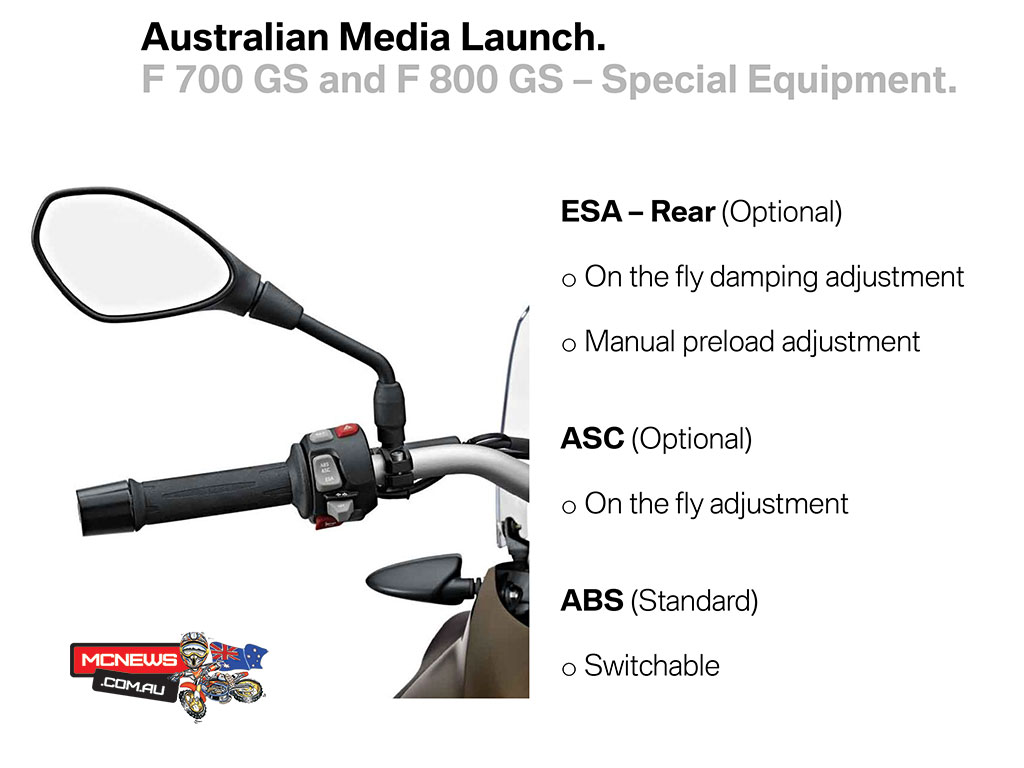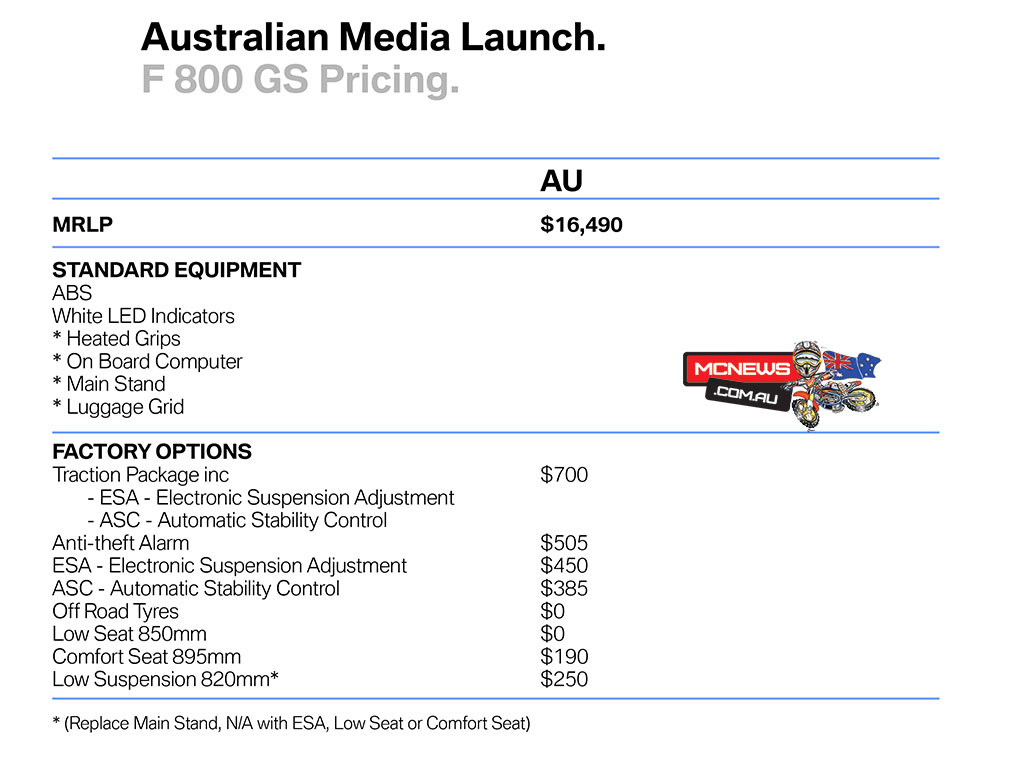2013 BMW F 800 GS Road Test
By Trevor Hedge
BMW have completed a comprehensive make over on the F 800 GS to help meet competitor challenges head on, with a combination of features unparalleled in the medium capacity adventure-touring category.
The engine has also come in for some mid-life tweaks with seemingly a little more zest injected throughout the rev-range, yet remaining as eminently frugal as ever. It still feels slower than it is, and still sounds a bit like a wet fart in a tin can, but remains effective and confidence inspiring. Never threatening or intimidating, it never feels as though it is trying and thus you seldom realise just how fast you are actually being thrust forward. Look at the speedo as it passes go to jail: do not pass go, do pay the government lots of money numbers with alarm as you realise that this 800cc parallel twin has just propelled you out of the last corner to speeds that would have safety Nazis and tabloid newspapers apoplectic with rage. That’s not to say, the F 800 is some sort of sportsbike like 10-second quarter mile on the back wheel beast, but it is faster than it feels. That is all well and good, but I prefer a little bit of feral on the end of my twistgrip, thus for me, the engine disappoints a little on road. But I did find the motor in these latest machines a little smoother and less harsh than their predecessors.
Off road, where traction is problematic and your skills start to get challenged, is where the donk really fulfils its duties with a sense of honest purpose. Its lack of anger allows the rear to find traction where it has no right; this is a character trait that off-road novices and cautious riders will hold in high regard, and allow them to get to places they otherwise might not have dared. It inspires confidence. Which for the F 800 GS, the lighter and more immediately approachable option to the somewhat daunting, to the uninitiated, big brother R 1200 GS, is probably the exact design brief BMW engineers were tasked with in the creation of a more affordable and more approachable option to the big daddy of adventure bikes.
The headline new acts of electrickery (for the F 800) are traction control and electronic suspension adjustment. These useful features combine with the existing ABS, tyre pressure monitoring and heated grips featured on their predecessors, cementing BMW’s position at the forefront of two-wheel technological development.
While electronics are all well and good, it is the individual mapping of these components that are the make or break in the real motorcycling world. First generation systems were, to be frank, crap. They only detracted from the riding experience. Those days are long gone, and good riddance.
Like all modern BMW motorcycles, the mapping of their electronic aids are brilliant. While I have no first-hand experience with BMW’s development team or their processes, I can tell that their, obviously extremely competent, test riders have the influence and respect of their engineers. Computer simulations are all well and good, but they should only form the base tune of any system. It is real world testing by real life motorcyclists that has now, (and I would say for the last few years), put the BMW systems at the forefront of electronic rider aids. Other European brands have followed suit and have introduced similarly useful aids to the mainstream. The Japanese brands, once the brave innovators, are still being rather dumb in this area after curling up in the foetal position during the global financial crisis, they remain too scared to do anything innovative.
On the road the ABS system on the F 800 GS is excellent and the new improved Brembo hardware they interface with are certainly a step above what adorned the machine before. While the previous hardware worked well enough, it didn’t really have that immediacy of feel at the lever that inspires rider confidence. And for me, along with most riders, that is what separates an average motorcycle from a good motorcycle. The ‘feel’ is all important, and here the F 800 GS offers a marked improvement and thus more riding enjoyment. On previous machines ABS was optional but for the 2013 model year this feature is now standard on the F 800 GS.
Off-road the brakes are also quite effective but for the rear brake sliders and more adventurous dirt riders the ABS is still best switched off. That’s not to say the ABS is bad off-road. It is actually quite good, in most situations, and for inexperienced or just very cautious riders ABS can be left on 100 per cent of the time. Those of us that like to attack on corner entry by braking later with less margin for error, and/or like to step the rear out on entry, there is still no substitute for having full and fine control at all times of the amount of skid or stopping power available at the levers, with no electronic/hydraulic interference. BMW know this, that is why they provide an off button for the ABS system, and I, along with all other control freaks, love them for it.
While traction control is a useful safety aid, particularly on roads where diesel spills and various other impediments to traction may appear unexpectedly, the F 800 GS is no animal and thus perhaps not the obvious candidate for such a system. It is nice to have in the background for general street riding but the lack of a ‘sport’ setting, unlike big brother R 1200 GS, means the systems parameters are quite strict and allows no sliding off-road. This is somewhat of a disappointment. The R 1200 GS system in ‘sport’ mode is simply amazing, and allows for long high-speed drifts without intervention. Surely the components and computer power is there on the F 800 GS, so why not just add another user selectable map? Alas, BMW have not granted us such a feature on the 800 thus while I am happy to always ride with an R 1200 GS with sport mode traction control activated, off-road on the F 800 GS I will turn the system off, always. Many riders will be completely happy to leave the system on and find it no hindrance to their riding pleasure, but I am a hoon and I absolutely must be able to slide a bike around when off-road or I will spontaneously combust from frustration. But again that’s me, you may well be completely different.
The electronic suspension adjustment functionality, while very welcome, and the first in this medium-capacity and more affordable sector of the adventure-touring category, also lacks some of the features of the R 1200 GS ESA system. Big brother is adjustable everything, at both ends. The F 800 GS makes do with electronically adjustable rear damping control only, albeit on the fly and hugely effective and thus still definitely worthwhile.
As soon as you hit the trail select comfort mode and let the damping soften up and absorb the irregularities more freely, allowing for more traction and a much smoother off-road ride, along with better off-road performance. Pop out of the dirt and on to a nice stretch of tar, as we did repeatedly on test, select sport mode and immediately feel the damping circuits tauten ready for action and work with you attacking every bend while pretending to be a sportsbike. It’s brilliant, but would be better if the same feature also worked on the front forks as when you really start to get right up it you can feel the mismatch between the rear and front ends. It’s not a big deal, you ride around it and work with what you have, but I know BMW can do better, as they do on the R 1200 GS.
The combined ‘Traction Package’ including ESA and traction control is a reasonable $700 option. ABS is now standard.
This sounds more like a review of why the F 800 GS is not a good a motorcycle as the R 1200 GS, rather than a standalone examination of the attributes of the vastly improved 800 machine. I make no apology for that. While some of the test riders on the launch, all of which are very experienced and competent riders, disagree with me in regards to the comparative value of the 800 with many of them saying over lunch on day two, “Why would you buy a 1200?” In answer, I would say, that while I enjoyed the F 800 GS immensely and can admire it for what it is, there was not one single minute of the two-day launch ride that I would not have been having much more fun on the big jigger.
Of course you save approximately 5k by going the 800 route, and some riders will never get a handle on the more expensive and much larger boxer 1200 and thus the 800 makes perfect sense and will take them to places they would never dare tread on the 1200. However, if you are a bit of a hoon and also a connoisseur of fine things, there is no substitute for the all-round brilliance of the R 1200 GS. It’s just a better and more rewarding bike – simple really.
With the 800, and it’s more road oriented F 700 GS sibling, likewise the also recently updated single-cylinders options in the G 650 GS and its more off-road focussed Sertao stablemate, BMW have pretty much all bases covered in the adventure-touring segment. Just choose the machine and price point that suits.
And talking of price… BMW have dropped the prices across their entire range. At $16,490 (plus on road costs) the F 800 GS is now $2265 cheaper than before. That’s perhaps the handiest change of all…


























